Before we make a building, we calculate a number of quantities which will ultimately decide the fate of the building. One of the first things we calculate are the loads involved, that is dead, live, wind, seismic loads etc.,
We design a structure such that whole of its weight is evenly distributed and not concentrated to a single point. Loads transfer their weights to the beam, beam transfers it via column and then it ultimately is transferred to the foundation of the structure. The building or any other structure transfers its whole weight it experiences to the foundation of the building.
Every component here is transferring its weight to a more stable component which is actually balancing the weights or transferring it to the next stable member.
But have you ever thought where the foundation transfers its load?? Yes, it transfers it to the ground or the earth below it. But what is ground actually?? Ground is made up of layers of soil or Rocks. These are the ultimate members which are bearing the whole weight of the structure. So therefore, we can say that a building is actually supported by the soil beneath it.

What is Soil?
Soil is a relatively loose material on the earth’s surface consisting of fine rock particles and organic matter. Soil is the most important aspect to be checked before starting a construction because if the soil is not good or if it doesn’t have a high bearing capacity, it is not suitable for the structure.
Soil testing is done before starting a project to check the health of soil, example- we check salinity, acidity, water content, air voids, chemicals present if any, density and so on. We have different tests to determine the above factors, but first let us get known to the various types of soil found in India.
Types of Soils In India
Climate of a region extensively decides the type of soil present in that region. The three things that majorly decide the soil type are: Temperature, Water availability, Location (due to climate). Based on this, the various types of soil found in India are as follows:
- Alluvial: Largest group of soil found in India. It is present on above 80% of land surface in India. Most sought after soil for crop growth and farming (fertile). It is formed by silt carried by river, and is mostly found in northern plains.
- Black: Found in Deccan lava region of Maharashtra, Gujarat and Madhya Pradesh. This can retain moisture for a longer time.
- Red: Deficient in humus, phosphorus and nitrogen.
- Laterite: Found in tropical regions with high rainfall.
- Forest: Found at slopes of hills and mountains.
- Arid: Found in dry regions as deserts.
- Saline/Alkaline: Found in Andhra Pradesh and Karnataka, and other drier regions
- Organic/Peat: Found in Humid regions
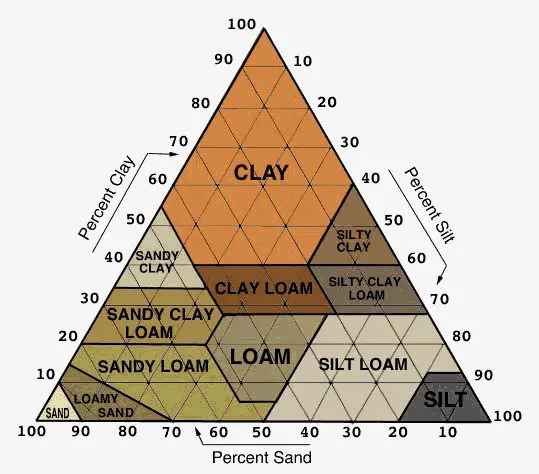
Testing of Soil for House Construction at site
Soil Investigation can be done by- Inspection, Test-pits, Probing, Boring
Inspection, as name gives the idea, is the general inspection or preliminary examination of the site. What we see is generally the inspection.
Test pits are dug by hand or by excavating machines. The size of the pit should be such that a person can easily enter the pit and have a visual inspection. Both disturbed and undisturbed soil samples are collected from the pit for detailed analysis.
In Probing, a steel bar of up to 40 mm thickness is driven through the ground until it can’t go further or a hard surface comes in its way. The bar is then forcefully put down by hammer. After that the bar is removed, the soil stuck on the bar can give a lot of idea about the quality of soil.
In Boring, bore holes are made up in the ground and samples of soil are collected from it. As a rough estimate, it is advisable to investigate the soil to the depth twice of the anticipated largest size of the foundation.
Soil on site is classified based on-
- Grain size
- Plasticity
Grain size of soil can be described as the size of a single individual particle of soil, obtained when it passes through an IS sieve. Soil is allowed to fall freely through a sieve, and the sieve it easily passes through and is not filtered by, determines its sieve number.
Plasticity, in simple terms, is the ability of soil to undergo deformation without cracking or segregating. Water absorption by soil increases its plasticity. Soil only tends to be plastic when it has clay present in it.
The various tests involved in determining properties of soil are as follows:
Test#1. Determination of Water Content
The water content may be determined by the following methods:
a. Oven Drying method
This is the most accurate method of determining the water content. According to this, four masses are taken as
M1- Mass of container with lid
M2- Mass of container with lid and wet soil
M3-Mass of container with lid and dry soil
Then water content, W is = ((M2-M3)/M3-M1)) x 100%
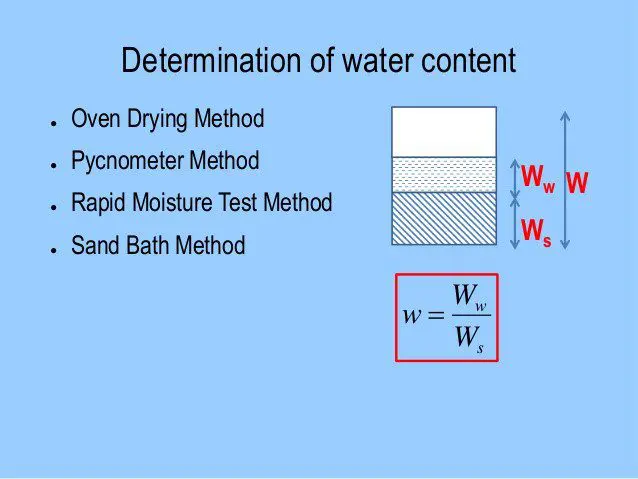
B. Sun Bath Method
This method is used on field to get a rough estimate of the water content, when oven is not present.
C. Calcium Carbide Method
This method is used when water content is to be quickly determined.
D. Pycnometer Method
This method is also used to get quick results when the specific gravity is pre known, and only suitable for coarse grained soil.
Test#2. Determination of Specific Gravity
Specific gravity (G) of soil can be described as ratio of weight of given volume of soil at a given temperature to the weight of equal volume of distilled water at that temperature, or in other words, ratio of unit weight of soil to that of water.
It is determined either by a density bottle method or by a pycnometer method. Density bottle method is accurate and suitable for every soil type, whereas pycnometer method is only for coarse grained soil.
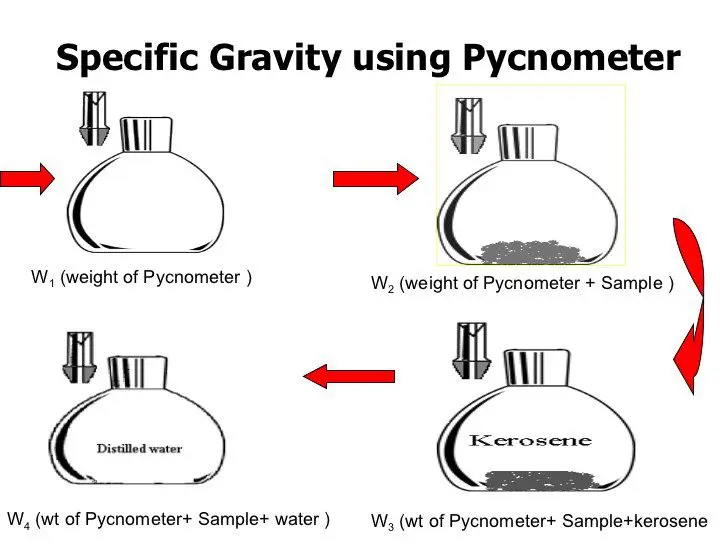
According to it, G = ((M2-M1)/ ((M2-M1) +M4-M3)))
M1= mass of pycnometer
M2= mass of pycnometer and dry soil
M3=mass of pycnometer, soil solid and water
M4=mass of pycnometer and water
test#3. Determination of Particle Size
It is calculated by analysis and performed via two stages, that is, sieve analysis and sedimentation analysis.
The sieve analysis is done when all particles do not pass through sieve of 75 microns.
The smallest sieve size according to Indian standards is 40 microns.
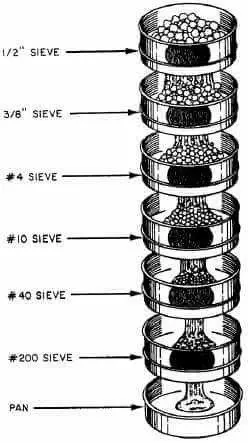
Sedimentation analysis is used to determine the grain size distribution of soils whose grains are finer than 75 microns (0.075mm). It is done by the help of hydrometer or a pipette. Assumptions are made which are-
-Soil particles are spherical
-Particles settle independently of each other
-Walls of jar in which it is kept do not affect the settlement
Hydrometer is used to determine the density of the soil suspension.
Pipette method is generally used in indoors lab.
Test#4. Determination of Consistency of the Soil
Consistency means, either the soil is hard, stiff, firm, or soft. This term is used mostly for fine grained soil. The fine grained soil can have plastic state when water is added to it, which then can take any shape given to it. Water reduces cohesion making it easier to mould. The four limits of consistency are:
Atterberg limits- The atterberg limits most useful for the engineering purposes are liquid, plastic and shrinkage limit.
- Liquid limit- Defined as minimum water content at which soil is still in liquid state.
- Plastic limit- Minimum water required which can make soil to roll into 3mm diameter threads.
- Shrinkage limit- It is the maximum water content of soil at which reduction in its moisture does not tend to lead reduction in volume of soil.
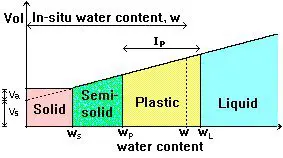
Some Other Tests Conducted on Soils are:
Following are some of the tests conducted on soil. These tests are not typically required for low rise construction work but are to determine the soil characteristics to design high rise structures, flexible pavements (roads) etc.,
Test#1. Standard Penetration Test
It is the most common test performed for the cohesion less soil type. It is helpful in determining the relative density and the angle of shearing resistance.
The standard penetration test is conducted in a bore hole using a standard split spoon sampler. When the bore hole has been drilled to the desired depth, the drilling tools are removed and the sampler is lowered to the bottom of the hole.
The sampler is driven into the soil by a drop hammer of 63.5kg mass falling through a height of 750mm at the rate of 30 blows per minute (IS – 2131: 1963). The number of hammer blows required to drive 150mm of the sample is counted. The sampler is further driven by 150 mm and the number of blows recorded.
Likewise, the sampler is once again further driven by 150mm and the number of blows are recorded. The number of blows recorded for the first 150mm is disregarded. The number of blows recorded for last two 150mm intervals are added to give the standard penetration number (N).
In other words, the standard penetration number is equal to the number of blows required for 150mm penetration beyond seating drive of 150mm.

Standard Penetration Test
Test#2. Plate Load Test
It is used to get determine the bearing capacity of the soil and settlement of the foundation for clayey and sandy soil. In this test compressive stress is applied to the soil layer through rigid plates of large size and the deflection/settlement is measured for various stress values.
The test is carried out at the level of proposed foundation.
Bearing Plate:
- Mild Steel Bearing Plate in circular or square shape
- Dimension: 30 cm, 45 cm, 60 cm, or 75 cm
- Thickness of plate > 25 mm
- Bottom of the plate is grooved for increased roughness
- Concrete blocks may be used to replace bearing plates
Test Pit:
- Usually to the depth of foundation depth
- Width equal to five times the test plate
- Carefully leveled and cleaned bottom
- Protected against disturbance or change in natural form
A pit is excavated to the level at which foundations is to be laid. After excavation of pit, at center of excavated pit steel plate sized hole with D thickness is excavated and arrange the plate in it. After arranging the plate in central hole hydraulic jack is arranged on top of plate to apply load. Reaction beam or reaction truss is provided for the hydraulic jack to take up the reaction. Otherwise a loaded platform is created (using sand bags etc.) on the top of hydraulic jack and provided the reaction.
A load of 7kN/m2 is applied to set the plate and released after some time. An incremental load is applied with an increment of 20% of safe load.
Settlements are recorded using a dial guage after periodic intervals (usually after each hour) until the total settlement of 25mm has occurred.
Test#3. California Bearing Ratio Test
The California bearing ratio test is penetration test meant for the evaluation of subgrade strength of roads and pavements. The results obtained by these tests are used with the empirical curves to determine the thickness of pavement and its component layers. This is the most widely used method for the design of flexible pavement.
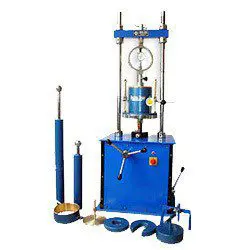
Test#4. Vane Shear Test
The vane shear test can be used to determine the sensitivity of the soil. After the initial test, the vane is rotated rapidly through several revolutions such that the soil becomes remoulded.
The test is repeated on the re-moulded soils and the shear strength in remoulded condition is determined. It is ideally suited for the determination of the undrained shear strength of non-fissured fully saturated clay. The test can be conducted in soft clays situated at a great depth, samples of which are difficult to obtain.

Test#5. Triaxial Shear Strength Test on Soil
The specimen is subjected to an all-round fluid pressure in the cell, consolidation is allowed to take place, and then the axial stress is gradually increased by the application of compressive load through the ram until failure of the specimen takes place, usually on a diagonal plane.
Soil beneath the structure decides the load the structure can carry and the type of foundation that needs to be laid. If soil study is not done before construction, then it could lead to disastrous consequences, as overturning of the building. Therefore, we can conclude that soil case study is a MUST to investigate the characteristics of the underlying soil.





